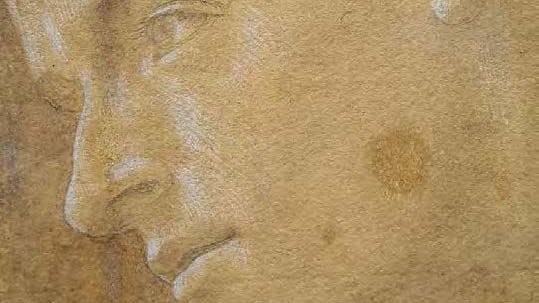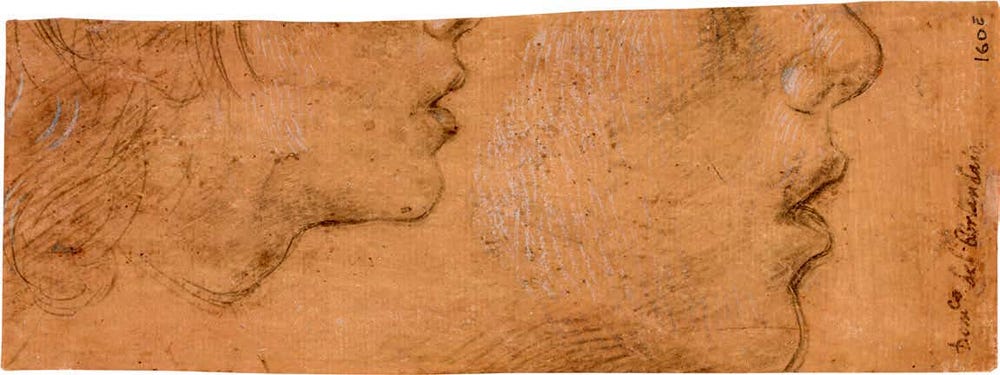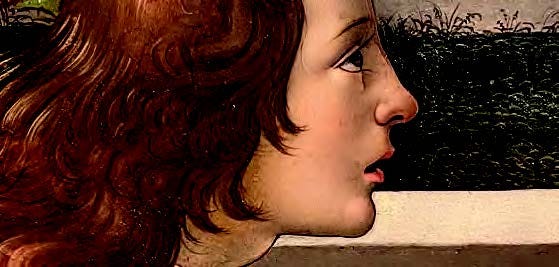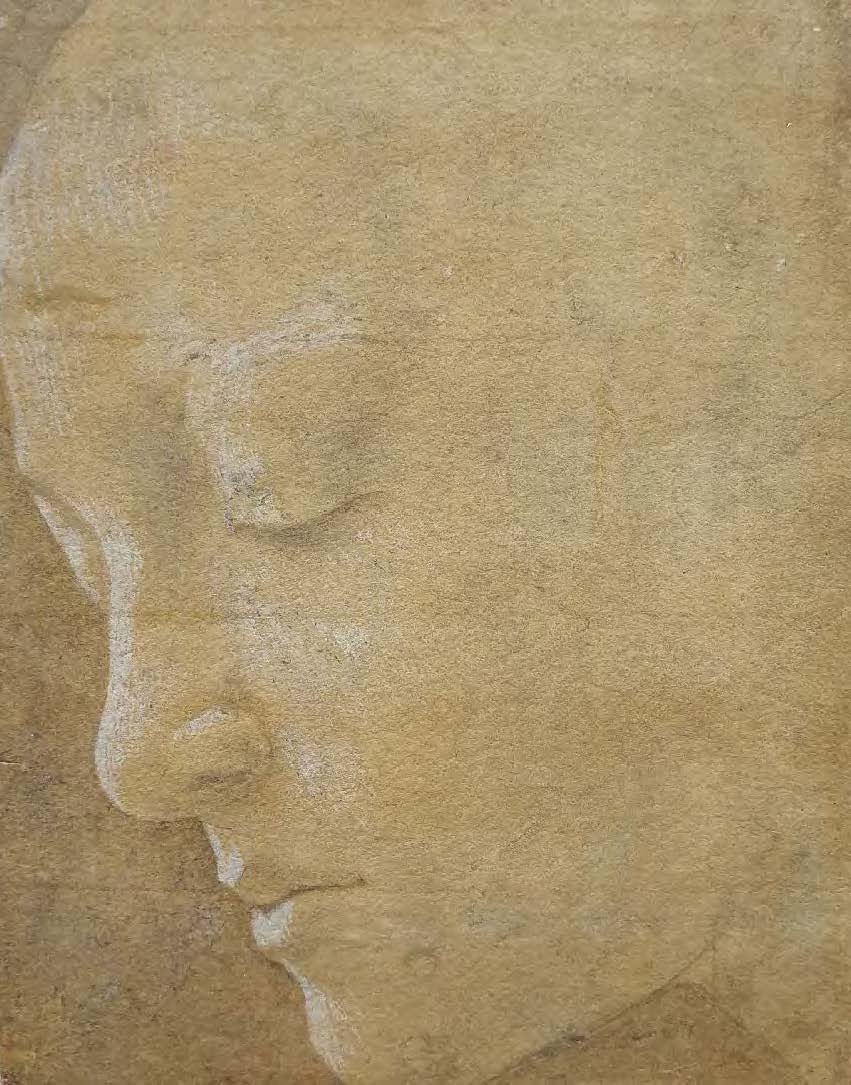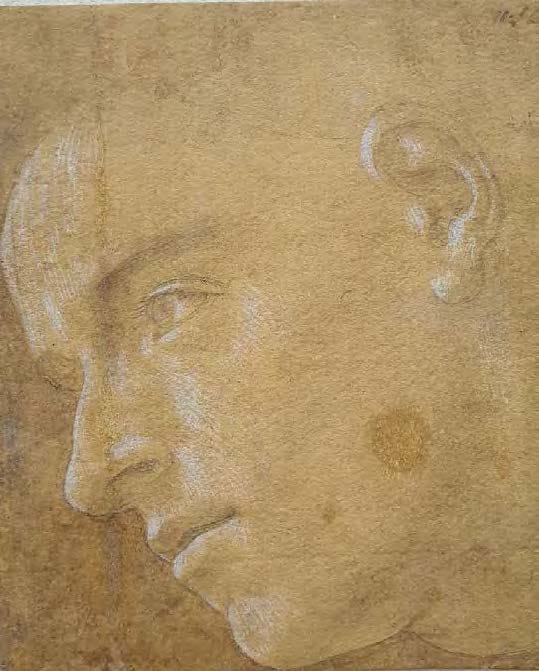Fine Arts Museums Announce Newly Attributed Botticelli Drawings
Apr 3, 2023
Head of a man in near profile looking left, here attributed to Sandro Botticelli. c. 1468-70. Traces of black chalk, metalpoint (lead?) heightened with white and grey wash, on yellow-ochre prepared paper, 13.2 x 11 cm. (Christ Church Picture Gallery, Oxford)
Research for major Botticelli exhibition opening November 19 at the Fine Arts Museums of San Francisco leads to several new attributions to the artist
SAN FRANCISCO – Opening November 19 at the Fine Arts Museums of San Francisco–where it is presented exclusively at the Legion of Honor–the landmark exhibition Botticelli Drawings reunites rarely seen works from 39 lending institutions for the first time in modern history. Anchored by the artist's paintings, the exhibition breaks ground in its exploration of the central role of drawing as the dynamic force behind Botticelli’s compositions. Thorough research undertaken by Fine Arts Museums’ curator Furio Rinaldi in preparation for Botticelli Drawings has led to several new attributions to this quintessential artist of the Italian Renaissance, three of which are announced here for the first time, including preparatory drawings for renowned paintings The Cestello Annunciation (1489, Uffizi Gallery), Adoration of the Magi (c. 1470-1475, National Gallery of Art, Washington, D.C.), and Virgin and Child with the Young Saint John the Baptist (c. 1468-70, Louvre Museum). The latter painting will be on view alongside its newly attributed preparatory drawing in the upcoming exhibition.
“Furio Rinaldi, the Fine Arts Museums’ Curator of Drawings and Prints, has done exceptional research in the years leading up to our Botticelli exhibition, which in itself promises to be a groundbreaking presentation on the centrality of draftsmanship to this world-renowned artist’s practice,” remarked Thomas P. Campbell, Director and CEO of the Fine Arts Museums of San Francisco. “We are pleased to share just some of the fruits of that close and careful scrutiny now, with the announcement of three drawings newly attributed to Botticelli by Rinaldi. These works will be on view at the Legion of Honor come November, one of them alongside the celebrated painting with which it corresponds–the Louvre’s Virgin and Child with the Young Saint John the Baptist (c.1468-70).”
Known for some of the world’s greatest paintings, Sandro Botticelli has had an enduring influence on contemporary culture, from art and design to dance, music, fashion, and film, inspiring artists such as Andy Warhol, Jean Paul Gaultier, Cindy Sherman, and Salvador Dalí, among others. Although Botticelli was an expert draftsman and one of the first artists to make draftsmanship central to his aesthetic and design practice, his surviving drawings are surprisingly scarce, with fewer than thirty securely attributed sheets in existence today. One reason for this paucity is the extremely poor survival rate of drawings from the era. The other is the unconventional stylistic progression, most pronounced in his drawings, that makes attribution to the artist particularly challenging.
Amongst more than 60 works on view, Botticelli Drawings features 27 drawings by the artist, exploring the medium as his primary form of artistic expression and key to his aesthetic and enduring popularity. Furio Rinaldi, Curator of Drawings and Prints at the Fine Arts Museums of San Francisco, has made a number of new attributions throughout the course of his extensive research in the lead up to the exhibition. Of those, two were executed in preparation for celebrated early paintings Adoration of the Magi (c. 1470-1475) and Virgin and Child with the Young Saint John the Baptist (c.1468-70), the latter on loan for the exhibition from the Louvre Museum. These two drawings from the historic graphic collection of Christ Church Picture Gallery, Oxford–Head of a man in near profile looking left and Head of a woman looking down to the left–are reintroduced here with an attribution to Botticelli on the basis of technical and stylistic analysis, and connections to these early paintings by him.
Drawn in the same technique and of similar size, the drawings were likely cut from the same ochre-yellow prepared sheet of paper, and are both currently filed as anonymous 15th-century works at Christ Church. The study of the woman can be linked with the head of the Virgin, tenderly looking down in near profile to her child, in the latter painting, while the young man can be connected with the third onlooker on the right in the former. Both drawn delicately in metalpoint with selective use of heightening in white lead, the two facial types on the Oxford sheets were adapted by Botticelli in other early works, who repurposed and repeated his graphic designs in a way that would become customary for his workshop, as will be revealed in the exhibition at the Legion of Honor.
The third sheet newly attributed to Botticelli comes to the exhibition from the graphic holdings of the Uffizi Gallery, the Gabinetto Disegni e Stampe degli Uffizi, and depicts two lively studies for a head of a youth in profile. It is reintroduced here as a match with the profile of the Archangel Gabriel in the celebrated Cestello Annunciation, painted by Botticelli in 1489, and also within the collection of the Uffizi. Executed on yellow-ochre prepared paper in metalpoint, these studies accord closely with the shadows and fall of light on the figure in the painting, who is shown with his mouth open while speaking to the Virgin Mary. As one of the most prolific portrait artists of his time, Botticelli had a particular interest in executing precise, evocative head studies, which represent a relatively large proportion of his body of surviving drawings. Indeed, his portraits have endured through centuries as potent symbols of beauty.
“I am thrilled to share my new findings, to be fully unveiled in our Botticelli Drawings exhibition in November," noted Furio Rinaldi. "Exhibitions like this one represent an invaluable tool for art historical investigation. I am grateful to our colleagues Jacqueline Thalmann at Christ Church Picture Gallery and Eike Schmidt at the Gallerie degli Uffizi for facilitating my research during challenging times between 2020 and 2021. These new proposed attributions will help lay the groundwork for a fuller understanding of Botticelli’s artistic output and the field of Italian Renaissance art at large."
Offering insight into his transformative method of composition and design process, Botticelli Drawings brings together the majority of the artist’s surviving graphic output, illuminating the creative process behind his most memorable masterpieces. The new attributions are treated extensively in the exhibition catalog, to be published by the Fine Arts Museums of San Francisco and Yale University Press.
Exhibition Organization
Botticelli Drawings is organized by the Fine Arts Museums of San Francisco. Presenting Sponsors are John A. and Cynthia Fry Gunn, Diane B. Wilsey, and Barbara A. Wolfe. Major Support is provided by Roger Thomas and Arthur Libera and WOLFGANG RATJEN STIFTUNG, Liechtenstein. Significant Support is provided by Gretchen B. Kimball. Generous Support comes from Bettina S. Bryant, Christie’s, The Harris Family, Edina Jennison, Samuel H. Kress Foundation, The Robert Lehman Foundation, Maria Manetti Shrem, Lynn and Edward Poole, Mary Sauer, Robert Doris, and Annie Doris, The Tavolozza Foundation, David Wollenbarg, and Zenni. Additional support is provided by The Achenbach Graphic Arts Council, Luanne and Pete Andreotti, Alexandria and Dwight Ashdown, Sandra Bessières, Consulate General of Italy in San Francisco, Robert Dance, Stanlee Gatti, Italian Cultural Institute San Francisco, Wendy W. Kwok and family, Moretti Fine Art LD, Jan and Bob Newman, Christina Ongerth, and Parida Saennam, Austin Ligon, Sheila Wishek, and Andrea Woodner. This exhibition is supported by an indemnity from the Federal Council on the Arts and the Humanities.
About Sandro Botticelli
One of the world’s most famous and beloved artists, Alessandro di Mariano di Vanni Filipepi (Florence, ca. 1445–1510), known as Sandro Botticelli, epitomizes the flowering of the Renaissance in 15th-century Italy. Botticelli established his reputation and prosperous business from the late 1460s, as painter of portraits and religious images (notably, Madonnas). Yet it is his frescoes in the Vatican and a series of mythological pictures in the 1480s, distinguished by narrative ambiguity and sensual appeal—from La Primavera to The Birth of Venus—that ignited Botticelli’s later revival and ensured his continued popularity today. The quest for beauty and poetic ideas that underlie his art moved Botticelli to the highest hierarchies of the Medici family, which unofficially ruled Florence at the time. Much of his work is imbued with the philosophic ideas of the Florentine neo-Platonists surrounding Lorenzo the Magnificent, his most prominent patron, and later by the feverish spirituality of the Dominican friar Girolamo Savonarola, who took Florence by storm preaching against the rampant corruption of the Church.
About the Fine Arts Museums of San Francisco
The Fine Arts Museums of San Francisco oversee the de Young museum, located in Golden Gate Park, and the Legion of Honor, in Lincoln Park. It is the largest public arts institution in San Francisco and one of the most visited arts institutions in the United States.
The Legion of Honor was modeled after the neoclassical Palais de la Légion d’Honneur in Paris. The museum, designed by George Applegarth, opened in 1924 on a bluff in Lincoln Park overlooking the Golden Gate. It offers unique insight into the art historical, political, and social movements of the previous 4,000 years of human history, with holdings including ancient art from the Mediterranean basin; European painting, sculpture, and decorative arts; and the largest collection of works on paper in the American West.
The Fine Arts Museums of San Francisco respectfully acknowledge the Ramaytush Ohlone, the original inhabitants of what is now the San Francisco Peninsula, and we further acknowledge that the greater Bay Area is the ancestral territory of the Miwok, Yokuts, and Patwin, as well as other Ohlone peoples. Indigenous communities have lived in and moved through this land over hundreds of generations and Indigenous peoples from many nations make their home in this region today. Please join us in recognizing and honoring their ancestors, descendants, elders, and all other members of their communities.
Media Inquiries
Robyn Day \ Publicist \ rday@famsf.org \ 415-750-3554
